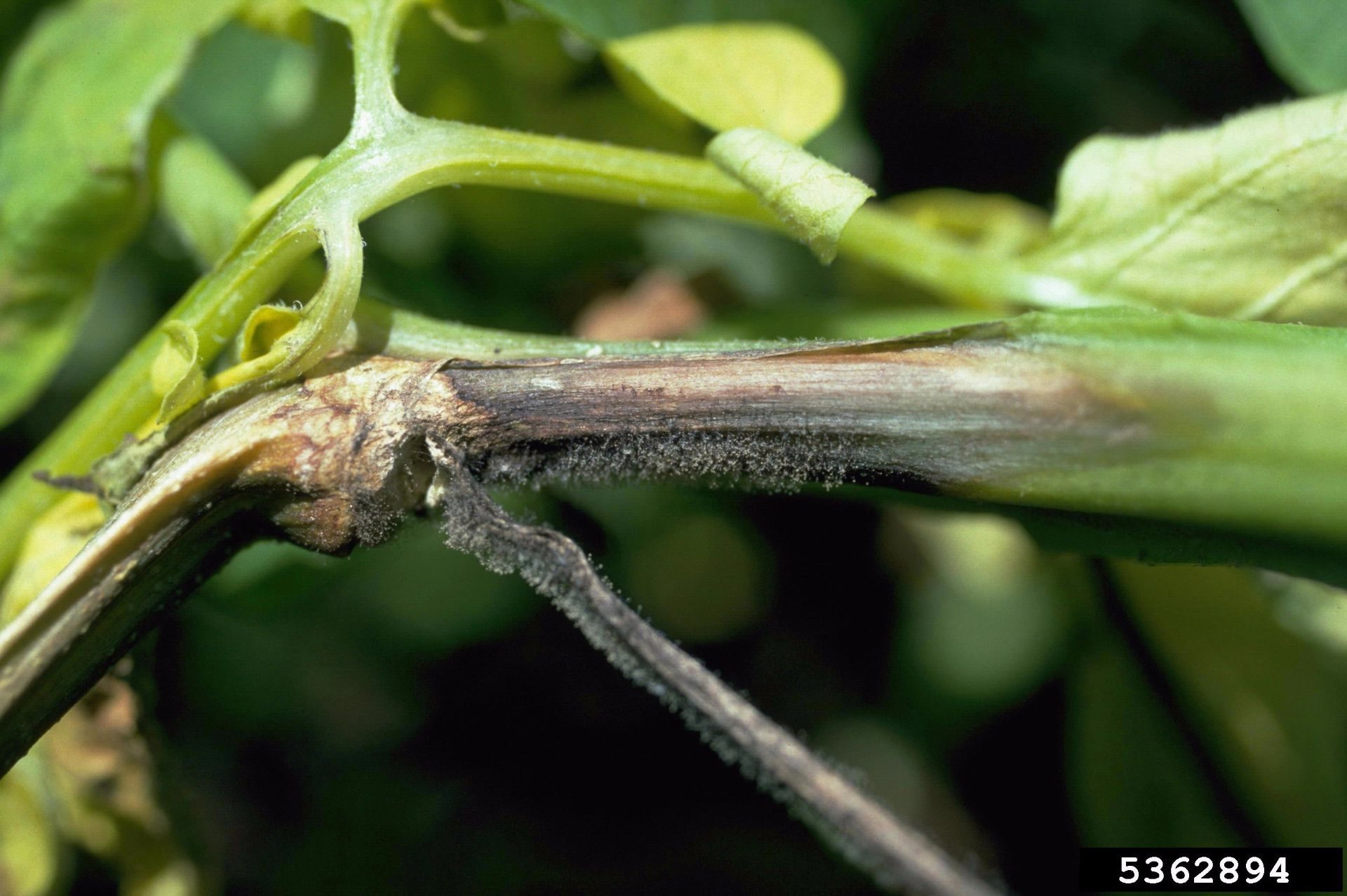
Late Blight
Phytophthora Infestans
Pathogen:
Oomycete
Type:
Risk:
CRITICAL
Phytophthora
Patata


WHO CAUSES IT?
Phytophthora infestans is an oomycete, often called water mold, that causes the disease known as late blight in potato crops. This pathogen reproduces through spores that are dispersed through the air and water, infecting potato plants in conditions of high humidity and moderate temperatures. During its life cycle, Phytophthora infestans can produce asexual spores (sporangia) that spread rapidly and cause infection in nearby crops.
SYMPTOMS
Late blight produces symptoms on potato leaves, stems and tubers. The leaves develop dark, moist Taches, which may be surrounded by a whitish halo. In the stems, the infection can cause necrosis and weakening of the plant. Infected tubers show dark, sunken lesions on the skin, which can extend to the pulp, causing rot.
• Dark, wet Taches on the leaves, surrounded by a whitish halo.
• Necrosis in the stems and weakening of the plant.
• Dark, sunken lesions on the tubers.
• Rotting of infected tubers.

TEMPERATURE AND HUMIDITY
15°C - 20°C
90% - 100%
TRANSMISSION ROUTES
Spores transported by air, water, direct contact with infected plants or tubers.
Do you want to remove this pest? Choose how you want to treat it.
TREATMENTS
Chemical treatments
• POTASSIUM PHOSPHONATES 25.5% (Exp. as phosphorous acid) + AZOXYSTROBIN 6.25% [SC] P/V
• POTASSIUM PHOSPHONATES 51% (Exp. as phosphorous acid) [SL] P/V
• CUPRIC HYDROXIDE 50% (EXPR. IN CU) [WP] P/P
• METALAXIL 25% [WP] P/P
• COPPER OXYCHLORIDE (Exp. in Cu) 52% [SC] P/V
• COPPER OXYCHLORIDE 25% (EXPR. IN CU) [WG] P/P
• COPPER OXYCHLORIDE 30% (EXPR. IN CU) [WP] P/P
• COPPER OXYCHLORIDE 35% (exp. in Cu) [WG] P/P
• COPPER OXYCHLORIDE 38% (EXPR. IN CU) [SC] P/V
• COPPER OXYCHLORIDE 50% (EXPR. IN CU) [WG] P/P
• COPPER OXYCHLORIDE 52% (EXPR. IN CU) [SC] P/V
• CUPROCALCIC SULFATE 12.4% (EXPR. IN CU) [SC] P/V
• CUPROCALCIC SULFATE 20% (EXPR. IN CU) [WG] P/P
Authorized treatments in organic farming
• POTASSIUM PHOSPHONATES 25.5% (Exp. as phosphorous acid) + AZOXYSTROBIN 6.25% [SC] P/V
• POTASSIUM PHOSPHONATES 51% (Exp. as phosphorous acid) [SL] P/V
• CUPRIC HYDROXIDE 50% (EXPR. IN CU) [WP] P/P
• COPPER OXYCHLORIDE (Exp. in Cu) 52% [SC] P/V
• COPPER OXYCHLORIDE 25% (EXPR. IN CU) [WG] P/P
• COPPER OXYCHLORIDE 30% (EXPR. IN CU) [WP] P/P
• COPPER OXYCHLORIDE 35% (exp. in Cu) [WG] P/P
• COPPER OXYCHLORIDE 38% (EXPR. IN CU) [SC] P/V
• COPPER OXYCHLORIDE 50% (EXPR. IN CU) [WG] P/P
• COPPER OXYCHLORIDE 52% (EXPR. IN CU) [SC] P/V
• CUPROCALCIC SULFATE 12.4% (EXPR. IN CU) [SC] P/V
• CUPROCALCIC SULFATE 20% (EXPR. IN CU) [WG] P/P
Biological control
• BACILLUS AMYLOLIQUEFACIENS subsp. plantarum (strain D747) 5% [SC] P/V
Recommendations
• Use potato varieties resistant to Phytophthora infestans.
• Apply specific fungicide treatments before and during risk periods.
• Improve field ventilation and drainage to reduce humidity.
• Avoid overhead irrigation, which can spread spores.
• Practice crop rotation to reduce the accumulation of spores in the soil.
• Regularly monitor crops for early signs of the disease.
Sponsored link
Sponsored link
Sponsored link
Sponsored link
Sponsored link
Sponsored link
Effective against all types of fungi
TREATMENTS
Homemade remedies
There are no home treatments
Natural allies
Chemical treatments
There are no treatments for this disease. Treatments are directed at the insect vectors that transmit it. See insect treatments.
RECOMMENDATIONS
- Check the back of the leaves frequently, especially in dry weather.
- Spray water on the leaves to increase humidity and prevent them from settling.
- Keep plants healthy with good watering and adequate light.
- If you see cobwebs or damage, clean the leaves with a damp cloth or pressurized water.
- Use potassium soap or neem oil every few days until they disappear.
REPELLENT PLANTS
Rosemary, Dill, Coriander
EFFECTIVE PRODUCTS TO ELIMINATE THIS PEST
Sponsored link
Sponsored link
Sponsored link
Sponsored link
Sponsored link
Sponsored link
Effective against all types of fungi
*The recommended treatments are recommendations based on the authorities' databases and do not replace in any way the guidelines established by the legislation of each country.
*Products shown are recommendations and not our own products. As Amazon Associates, we earn revenue from purchases of recommended products.






















